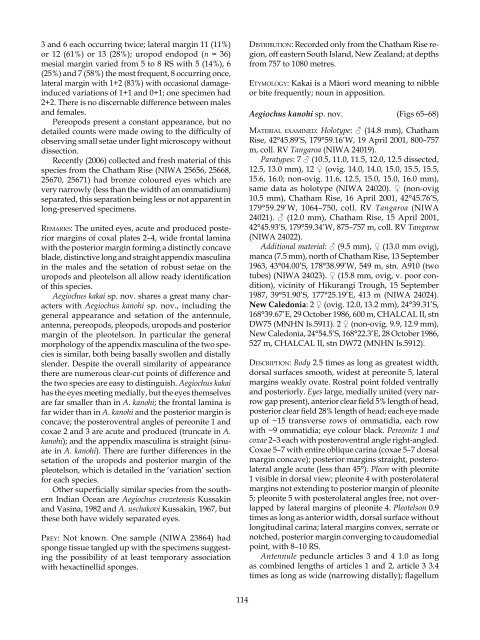The Marine Fauna of New Zealand: Isopoda, Aegidae (Crustacea)
The Marine Fauna of New Zealand: Isopoda, Aegidae (Crustacea)
The Marine Fauna of New Zealand: Isopoda, Aegidae (Crustacea)
Create successful ePaper yourself
Turn your PDF publications into a flip-book with our unique Google optimized e-Paper software.
3 and 6 each occurring twice; lateral margin ( %)<br />
or 2 (6 %) or 3 (28%); uropod endopod (n = 36)<br />
mesial margin varied from 5 to 8 RS with 5 ( 4%), 6<br />
(25%) and 7 (58%) the most frequent, 8 occurring once,<br />
lateral margin with +2 (83%) with occasional damageinduced<br />
variations <strong>of</strong> + and 0+ ; one specimen had<br />
2+2. <strong>The</strong>re is no discernable difference between males<br />
and females.<br />
Pereopods present a constant appearance, but no<br />
detailed counts were made owing to the difficulty <strong>of</strong><br />
observing small setae under light microscopy without<br />
dissection.<br />
Recently (2006) collected and fresh material <strong>of</strong> this<br />
species from the Chatham Rise (NIWA 25656, 25668,<br />
25670, 2567 ) had bronze coloured eyes which are<br />
very narrowly (less than the width <strong>of</strong> an ommatidium)<br />
separated, this separation being less or not apparent in<br />
long-preserved specimens.<br />
remarks: <strong>The</strong> united eyes, acute and produced posterior<br />
margins <strong>of</strong> coxal plates 2–4, wide frontal lamina<br />
with the posterior margin forming a distinctly concave<br />
blade, distinctive long and straight appendix masculina<br />
in the males and the setation <strong>of</strong> robust setae on the<br />
uropods and pleotelson all allow ready identification<br />
<strong>of</strong> this species.<br />
Aegiochus kakai sp. nov. shares a great many characters<br />
with Aegiochus kanohi sp. nov., including the<br />
general appearance and setation <strong>of</strong> the antennule,<br />
antenna, pereopods, pleopods, uropods and posterior<br />
margin <strong>of</strong> the pleotelson. In particular the general<br />
morphology <strong>of</strong> the appendix masculina <strong>of</strong> the two species<br />
is similar, both being basally swollen and distally<br />
slender. Despite the overall similarity <strong>of</strong> appearance<br />
there are numerous clear-cut points <strong>of</strong> difference and<br />
the two species are easy to distinguish. Aegiochus kakai<br />
has the eyes meeting medially, but the eyes themselves<br />
are far smaller than in A. kanohi; the frontal lamina is<br />
far wider than in A. kanohi and the posterior margin is<br />
concave; the posteroventral angles <strong>of</strong> pereonite and<br />
coxae 2 and 3 are acute and produced (truncate in A.<br />
kanohi); and the appendix masculina is straight (sinuate<br />
in A. kanohi). <strong>The</strong>re are further differences in the<br />
setation <strong>of</strong> the uropods and posterior margin <strong>of</strong> the<br />
pleotelson, which is detailed in the ‘variation’ section<br />
for each species.<br />
Other superficially similar species from the southern<br />
Indian Ocean are Aegiochus crozetensis Kussakin<br />
and Vasina, 982 and A. uschakovi Kussakin, 967, but<br />
these both have widely separated eyes.<br />
prey: Not known. One sample (NIWA 23864) had<br />
sponge tissue tangled up with the specimens suggesting<br />
the possibility <strong>of</strong> at least temporary association<br />
with hexactinellid sponges.<br />
4<br />
distribution: Recorded only from the Chatham Rise region,<br />
<strong>of</strong>f eastern South Island, <strong>New</strong> <strong>Zealand</strong>; at depths<br />
from 757 to 080 metres.<br />
etymoLogy: Kakai is a Mäori word meaning to nibble<br />
or bite frequently; noun in apposition.<br />
Aegiochus kanohi sp. nov. (Figs 65–68)<br />
materiaL examined: Holotype: ♂ ( 4.8 mm), Chatham<br />
Rise, 42°45.89’S, 79°59. 6’W, 9 April 200 , 800–757<br />
m, coll. RV Tangaroa (NIWA 240 9).<br />
Paratypes: 7 ♂ ( 0.5, .0, .5, 2.0, 2.5 dissected,<br />
2.5, 3.0 mm), 2 ♀ (ovig. 4.0, 4.0, 5.0, 5.5, 5.5,<br />
5.6, 6.0; non-ovig. .6, 2.5, 5.0, 5.0, 6.0 mm),<br />
same data as holotype (NIWA 24020). ♀ (non-ovig<br />
0.5 mm), Chatham Rise, 6 April 200 , 42°45.76’S,<br />
79°59.29’W, 064–750, coll. RV Tangaroa (NIWA<br />
2402 ). ♂ ( 2.0 mm), Chatham Rise, 5 April 200 ,<br />
42°45.93’S, 79°59.34’W, 875–757 m, coll. RV Tangaroa<br />
(NIWA 24022).<br />
Additional material: ♂ (9.5 mm), ♀ ( 3.0 mm ovig),<br />
manca (7.5 mm), north <strong>of</strong> Chatham Rise, 3 September<br />
963, 43°04.00’S, 78°38.99’W, 549 m, stn. A9 0 (two<br />
tubes) (NIWA 24023). ♀ ( 5.8 mm, ovig, v. poor condition),<br />
vicinity <strong>of</strong> Hikurangi Trough, 5 September<br />
987, 39°5 .90’S, 77°25. 9’E, 4 3 m (NIWA 24024).<br />
<strong>New</strong> caledonia: 2 ♀ (ovig. 2.0, 3.2 mm), 24°39.3 ’S,<br />
68°39.67’E, 29 October 986, 600 m, CHALCAL II, stn<br />
DW75 (MNHN Is.59 ). 2 ♀ (non-ovig. 9.9, 2.9 mm),<br />
<strong>New</strong> Caledonia, 24°54.5’S, 68°22.3’E, 28 October 986,<br />
527 m, CHALCAL II, stn DW72 (MNHN Is.59 2).<br />
desCription: Body 2.5 times as long as greatest width,<br />
dorsal surfaces smooth, widest at pereonite 5, lateral<br />
margins weakly ovate. Rostral point folded ventrally<br />
and posteriorly. Eyes large, medially united (very narrow<br />
gap present), anterior clear field 5% length <strong>of</strong> head,<br />
posterior clear field 28% length <strong>of</strong> head; each eye made<br />
up <strong>of</strong> ~ 5 transverse rows <strong>of</strong> ommatidia, each row<br />
with ~9 ommatidia; eye colour black. Pereonite 1 and<br />
coxae 2–3 each with posteroventral angle right-angled.<br />
Coxae 5–7 with entire oblique carina (coxae 5–7 dorsal<br />
margin concave); posterior margins straight, posterolateral<br />
angle acute (less than 45°). Pleon with pleonite<br />
visible in dorsal view; pleonite 4 with posterolateral<br />
margins not extending to posterior margin <strong>of</strong> pleonite<br />
5; pleonite 5 with posterolateral angles free, not overlapped<br />
by lateral margins <strong>of</strong> pleonite 4. Pleotelson 0.9<br />
times as long as anterior width, dorsal surface without<br />
longitudinal carina; lateral margins convex, serrate or<br />
notched, posterior margin converging to caudomedial<br />
point, with 8– 0 RS.<br />
Antennule peduncle articles 3 and 4 .0 as long<br />
as combined lengths <strong>of</strong> articles and 2, article 3 3.4<br />
times as long as wide (narrowing distally); flagellum

















